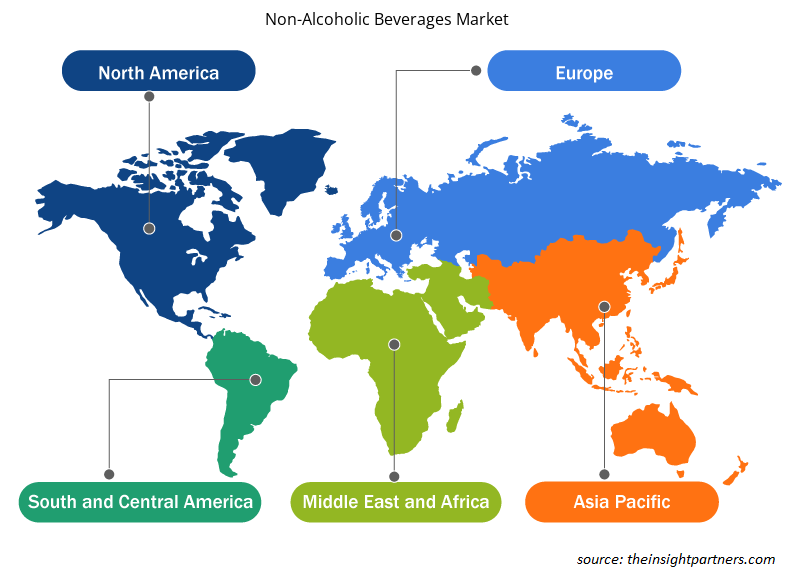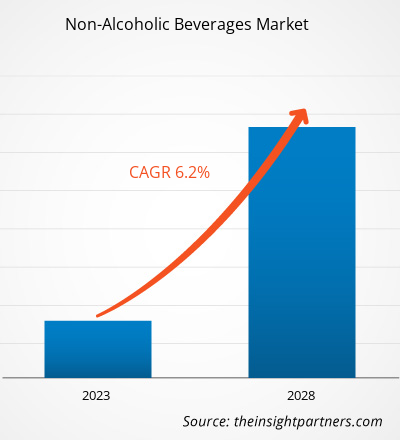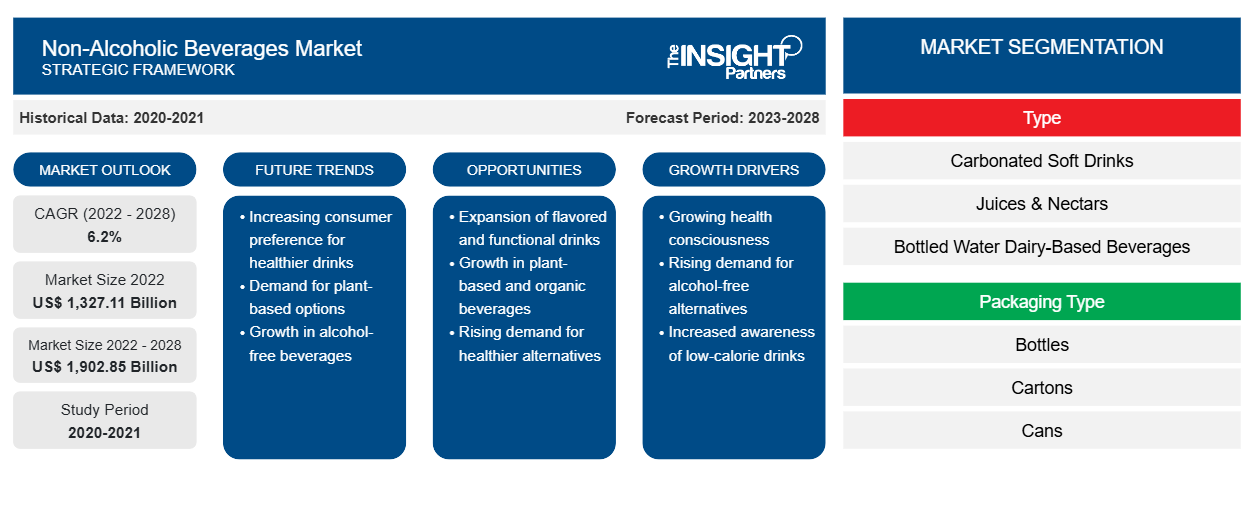非酒精饮料市场规模预计将从 2022 年的 13,271.1 亿美元增长到 2028 年的 19,028.5 亿美元。预计 2022 年至 2028 年的复合年增长率为 6.2%。
碳酸软饮料、瓶装水、果汁和果味饮料、乳制品和乳制品替代饮料、即饮茶和咖啡以及能量饮料是市场上不同类型的非酒精饮料。由于人们对健康的担忧日益增加,以及全球各国肥胖、糖尿病和心脏病的高发病率,无糖饮料在消费者中越来越受欢迎。由于人们越来越关注健康和营养,功能性饮料和强化饮料的需求量很大。由于对酒精饮料消费的严格规定和获得清真认证的麦芽饮料,非酒精麦芽饮料和预混料在沙特阿拉伯、伊朗和阿联酋等中东国家被广泛消费。这一因素推动了全球非酒精饮料市场中非酒精麦芽饮料细分市场的增长
2021 年,亚太地区占据了全球非酒精饮料市场的最大收入份额。推动亚太地区市场发展的主要因素是消费者健康意识的增强、对替代乳制品饮料的高需求以及天然和有机果汁的日益普及。在日本和韩国等国家,大多数人口都患有乳糖不耐症。这一因素正在推动这些国家乳制品替代饮料的普及。此外,由于潜在的消费者群体、对健康饮料的强劲需求以及广泛的零售环境,亚太地区的非酒精饮料市场利润丰厚。由于消费习惯的改变和消费者对健康饮食的日益关注,亚太地区对 NOLO(无/低酒精啤酒、烈酒和鸡尾酒)类别的需求显著增加。因此,许多提供无酒精或低酒精啤酒和烈酒的新兴公司正在扩大其在亚太地区的业务范围。例如,Sipfree 是一个无酒精啤酒、烈酒和葡萄酒的在线购物平台,于 2020 年 1 月在香港推出,尽管 COVID-19 疫情爆发,Sipfree 的销量仍大幅增长。此类扩张预计将在预测期内为亚太地区无酒精饮料市场的增长带来丰厚的机会。
定制此报告以满足您的需求
您可以免费定制任何报告,包括本报告的部分内容、国家级分析、Excel 数据包,以及为初创企业和大学提供优惠和折扣
-
获取此报告的关键市场趋势。这个免费样品将包括数据分析,从市场趋势到估计和预测。
COVID-19 疫情对非酒精饮料市场的影响
在疫情爆发前,非酒精饮料市场主要受到对健康饮料和便携饮料的高需求推动。然而,由于 2020 年 COVID-19 的爆发,许多行业面临前所未有的挑战。由于制造部门关闭和供应链中断,食品和饮料制造商在疫情初期增长缓慢。然而,消费者生活方式的转变、对健康饮食习惯的偏好增加以及注重健康的人口增加,大大促进了对非酒精饮料的需求。疫情爆发后,对豆奶、杏仁奶和椰奶等植物性饮料的需求增加了两倍,因为消费者认为植物性饮料比传统饮料更有营养价值。根据英敏特 2020 年 6 月发布的报告,25% 的受访英国消费者认为,由于疫情,纯素饮食似乎很有吸引力。这些因素对非酒精饮料市场的增长产生了积极影响。
健康和保健趋势是在 COVID-19 疫情爆发后引发的。消费者正在参与各种健身活动,例如瑜伽、慢跑和骑自行车以保持健康。这一因素预计将在未来几年 为非酒精饮料市场,尤其是能量和运动饮料领域提供强大的潜力。
市场洞察
运动饮料的普及推动非酒精饮料市场的发展
营养在提高运动表现方面起着重要作用。运动员和运动员必须遵循足够的营养来满足他们每天的能量和营养需求。除了专业运动员和运动员之外,许多人还从事日常体育活动以保持整体健康。近年来,由于人们对健康和保健问题的关注度增加,健身爱好者的数量有所增加。运动饮料可以补充运动和体育活动期间损失的电解质、水和能量。这些饮料通常含有碳水化合物、钾、钠、镁和钙,有助于补充水分、补充糖原储备并延缓运动后的疲劳。日益增长的健康和健身问题以及越来越多的体育爱好者是推动全球运动饮料销售的关键因素。因此,运动饮料的普及率不断上升,极大地推动了非酒精饮料市场的发展。
类型洞察
根据类型,全球非酒精饮料市场细分为碳酸软饮料、瓶装水、果汁和果冻饮料、乳制品饮料、乳制品替代饮料、即饮茶和咖啡、无酒精啤酒、麦芽饮料等。果汁和果冻饮料细分市场进一步细分为气泡果汁和其他饮料。碳酸软饮料细分市场在 2021 年占据了全球非酒精饮料市场的最大份额,而乳制品替代饮料细分市场预计在预测期内将以最快的复合年增长率增长。碳酸软饮料是一种由清水、糖、天然甜味剂或糖替代品(在减肥饮料中)、咖啡因、人工调味成分、果汁浓缩液、防腐剂和着色添加剂制成的碳酸非酒精饮料。雪碧、可口可乐、激浪和 Monster 是全球一些知名的软饮料品牌。碳酸软饮料在便利店、超市和大卖场、自动售货机、电影院、汽水店和在线零售店中随处可见。消费者生活方式的改变、可支配收入的增加以及对方便食品和饮料的需求不断增加,推动了碳酸软饮料市场的发展。
类别洞察
根据类别,全球非酒精饮料市场分为无糖和传统饮料。传统饮料在 2021 年占据了更大的市场份额。肥胖、糖尿病、高血压和心血管疾病的患病率不断上升,推动了对无糖饮料的需求。根据国际糖尿病联合会的数据,2021 年全球约有 5.37 亿人患有糖尿病。许多饮料制造商正在积极开发含有天然、低热量甜味剂的产品,以满足对无糖饮料日益增长的需求。这一因素正在推动该细分市场的市场发展。
非酒精饮料市场区域洞察
Insight Partners 的分析师已详尽解释了预测期内影响非酒精饮料市场的区域趋势和因素。本节还讨论了北美、欧洲、亚太地区、中东和非洲以及南美和中美洲的非酒精饮料市场细分和地理位置。

- 获取非酒精饮料市场的区域特定数据
非酒精饮料市场报告范围
| 报告属性 | 细节 |
|---|---|
| 2022 年市场规模 | 13271.1亿美元 |
| 2028 年市场规模 | 19028.5亿美元 |
| 全球复合年增长率(2022 - 2028) | 6.2% |
| 史料 | 2020-2021 |
| 预测期 | 2023-2028 |
| 涵盖的领域 |
按类型
|
| 覆盖地区和国家 |
北美
|
| 市场领导者和主要公司简介 |
|
非酒精饮料市场参与者密度:了解其对业务动态的影响
非酒精饮料市场正在快速增长,这得益于终端用户需求的不断增长,而这些需求又源于消费者偏好的不断变化、技术进步以及对产品优势的认识不断提高等因素。随着需求的增加,企业正在扩大其产品范围,进行创新以满足消费者的需求,并利用新兴趋势,从而进一步推动市场增长。
市场参与者密度是指在特定市场或行业内运营的企业或公司的分布情况。它表明在给定市场空间中,相对于其规模或总市场价值,有多少竞争对手(市场参与者)存在。
在非酒精饮料市场运营的主要公司有:
- 可口可乐公司
- 百事可乐
- 雀巢
- 红牛
- 三得利控股有限公司
免责声明:上面列出的公司没有按照任何特定顺序排列。

- 获取非酒精饮料市场顶级关键参与者的概述
全球非酒精饮料市场的主要参与者包括可口可乐公司、百事可乐、雀巢、红牛、三得利控股有限公司、达能公司、Califia Farms LLC、Keurig Dr Pepper Inc、朝日集团控股有限公司、Bolthouse Farms Inc.、喜力啤酒公司、Coolberg Beverages Pvt Ltd、Goya Foods Inc、百威英博和嘉士伯啤酒公司。全球非酒精饮料市场的参与者专注于提供具有新口味的有机、非转基因、植物性和无麸质产品,以满足不断变化的消费者需求。例如,2019 年,可口可乐欧太平洋合作伙伴为其 Honest Organic Lemonade 系列推出了两款气泡果汁。该产品由有机果汁和糖制成,不含甜味剂或人工香料。预计此类创新产品将获得巨大的消费者青睐,推动非酒精饮料市场的增长。
报告亮点
- 非酒精饮料市场的渐进式行业趋势,帮助参与者制定有效的长期战略
- 发达市场和发展中市场采用的业务增长战略
- 2020 年至 2028 年非酒精饮料市场的定量分析
- 全球非酒精饮料需求量估计
- 波特五力分析说明了行业内买家和供应商的效力
- 了解竞争市场状况的最新发展
- 市场趋势和前景,以及推动和抑制非酒精饮料市场增长的因素
- 通过强调支撑商业利益的市场策略来协助决策过程,从而促进市场增长
- 不同节点的非酒精饮料市场规模
- 市场详细概述和细分,以及非酒精饮料行业动态
- 各地区非酒精饮料市场规模及增长潜力
- 历史分析(2 年)、基准年、预测(7 年)及复合年增长率
- PEST和SWOT分析
- 市场规模、价值/数量 - 全球、区域、国家
- 行业和竞争格局
- Excel 数据集
近期报告
相关报告
客户评价
购买理由
- 明智的决策
- 了解市场动态
- 竞争分析
- 客户洞察
- 市场预测
- 风险规避
- 战略规划
- 投资论证
- 识别新兴市场
- 优化营销策略
- 提升运营效率
- 顺应监管趋势























 获取免费样品 - 非酒精饮料市场
获取免费样品 - 非酒精饮料市场